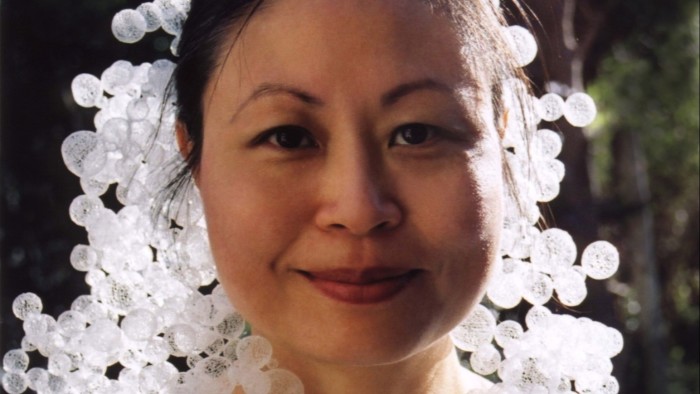Unlock the Editor’s Digest for free
Roula Khalaf, Editor of the FT, selects her favourite stories in this weekly newsletter.
The ebullient cluster of nylon bubbles that form the statement neckpiece made by Nora Fok is one of the standout exhibits at a recent show at the Goldsmiths’ Centre in London, Interwoven: Jewellery Meets Textiles. The piece is made from woven nylon monofilament, in other words fishing line, and is a fine example of how both the techniques of creating textiles and the fibres themselves have been used by jewellers down the centuries and across cultures.
The piece, called “Bubble Bath”, shows how an idea so skilfully realised can add an extra dimension to jewellery and what it can achieve. In this case lightness, playfulness and beauty.
It was made in 2001 and is in the Crafts Council’s collection. Fok says of the material she has used: “Nylon monofilament is lightweight and can easily be dyed, it is kind to the skin and a brilliant catalyst for light. Techniques like knitting, knotting and weaving are ideal for this material, they suit the imaginary world that is the essence of my work.”
Fok’s interest in jewellery began while studying at Brighton Polytechnic in the 1980s, where Caroline Broadhead was one of her tutors. Broadhead is a renowned artist, whose work has spanned a variety of disciplines, including jewellery. She was jewellery and textiles programme director and BA Jewellery Design course leader at Central Saint Martins art college in London, where she is now professor emerita.
Broadhead is a finalist in this year’s Loewe Craft Prize, worth €50,000, with a beaded chain that uses thousands of tiny, vibrantly coloured Japanese glass beads, threaded together using the peyote stitch, an ancient off-loom technique. Rolled paper is used as a guide to form the tubular links, and each link is made from 1,500 beads, taking a day to create.
Broadhead refers to this process as “meditative”, a reflection “on time, labour and the ways in which simple acts of repetition can be used to create complexity”. The links are formed by vertical and horizontal tubes that run perpendicular to each other, “creating endless possibilities for movement and interactions with the wearer’s body”.
“I first used textiles in my jewellery in the 1970s,” she says. “I started using embroidery threads, which were readily available and with a wide range of colours. At that time, using non-precious materials seemed to give more opportunities for exploring what jewellery could be. I was making the connection to clothing, both worn next to the skin and both very personal. At the moment, I am using glass beads to make jewellery — again for the range of colours.” An example of this work is a neckpiece made from cotton and silver, part of the Interwoven show.
There is an echo in Broadhead’s work with that of South African jeweller and academic Khanya Mthethwa, whose jewellery, showcased in a solo exhibition in Johannesburg earlier this year, is a celebration of the broad sweep of her country’s heritage and culture. Beadwork is central to her pieces, combining this heritage with the aesthetic of contemporary South African art jewellery.
Mthethwa says: “As artists and designers, we have a responsibility to reclaim our narrative and resist the erasure of our heritage. Heritage is not just about the past — it is a living force that shapes how we see ourselves and how the world sees us. A thriving community honours its cultural values, passing them down through generations. While oral tradition has preserved these stories, design offers a powerful way to express them — connecting the past, shaping the present, and inspiring the future.”
Daniel Kruger, one of the leading figures of art jewellery, was also born and raised in South Africa and is now based in Munich. His African influences can be seen in his work. But there are other influences too. One of his most recent pieces, showcasing beautiful beading and weaving techniques, is a necklace made from lapis lazuli beads, turquoise beads, brass, copper, coloured bone, gilded brass and silk. At its centre is the peace symbol, designed in the 1950s for the UK’s campaign for nuclear disarmament and which was adopted in the US in the 1960s by the anti-Vietnam war movement.
Seeing this symbol in Kruger’s necklace is not just a political message but also a pointer to a time when jewellery design was part of this counterculture and its experiments with a wide range of non-precious materials and the embracing of crafts and the handmade.
This was also a time when there was a renewed interest, particularly among women artists, in hand weaving and this revival worked its way into contemporary jewellery. An example of how hand-weaving techniques are today being used in fine jewellery was on show in another standout piece at the Goldsmiths’ exhibition — a gold cuff by London-based jeweller Nina Bukvic, made using fine gold wire.
The cuff is hand woven using only sewing needles and a jeweller’s mandrel. “It’s a meditative and rewarding practice,” Bukvic says, “that beautifully translates into the finished product . . . Gold becomes cloth-like, taking it back to ancient techniques, while giving it new aesthetics.
“I aim to create a body of work that belongs to both the past and present, something visually unfamiliar yet instantly captivating.”
Read the full article here

